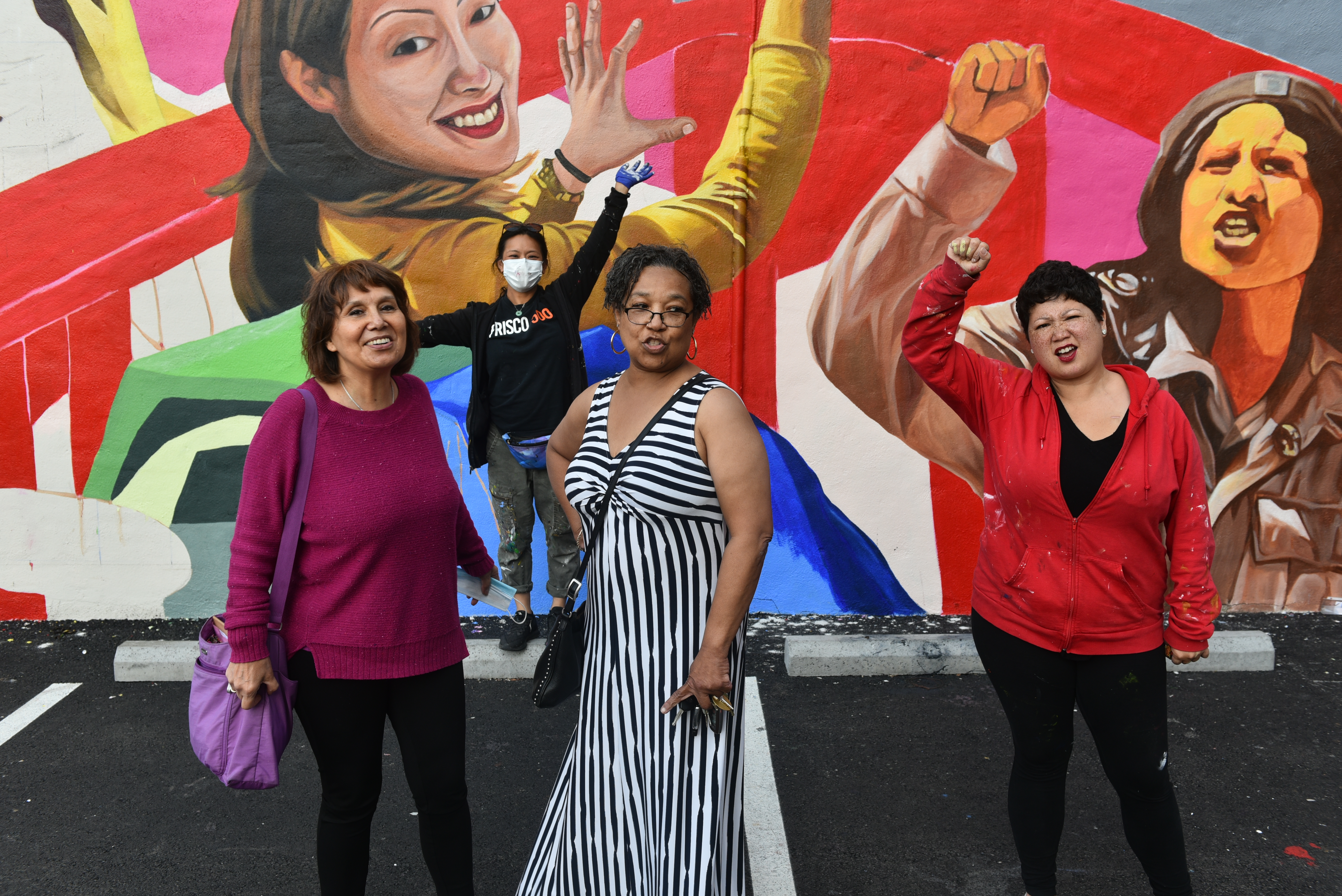If you’ve been in and around downtown Oakland recently, you may have noticed the new mural going up on the exterior wall of The Greenlining Institute’s building. If you’ve stopped and taken a peek, you may have seen muralists at work on scaffolds and a swingstage, filling in details, painting portraits, and making the wall come to life.
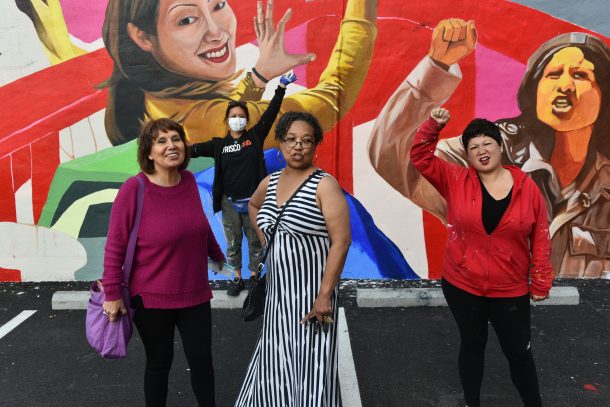
Marina Perez-Wong and Elaine Chu, aka the Twin Walls Mural Company, have been putting in hours and hours of hard work in their capacity as Assistant Artists for this project, known as the AscenDance mural. Observing them, it’s become evident that their work ethic is impeccable and their dedication to their craft is second to none.
In the first of what will be an ongoing series during the mural’s production, we invite readers to “meet the muralists” and learn about the people behind the painting, what drives them, and how they approach the work.
CRP: How did you become an artist?

Marina Perez-Wong: I learned how to draw before I could speak. My story’s a little different because I had a really rare cancer. My mom says that’s how I was trying to communicate initially, through drawing. That’s why I could draw before I could speak. And the, during my healing process I think she just realized, that was something that I gravitated towards that was something calming for me. And i could zone out. And she would joke that she would be talking to me, and I wouldn’t hear her. I would just be in my own world. I think that never dies, and I’ve just been like that my whole life. I’ll be working on a painting for ten hours straight.
Tell me about the evolution of your professional development. What got you to this point?
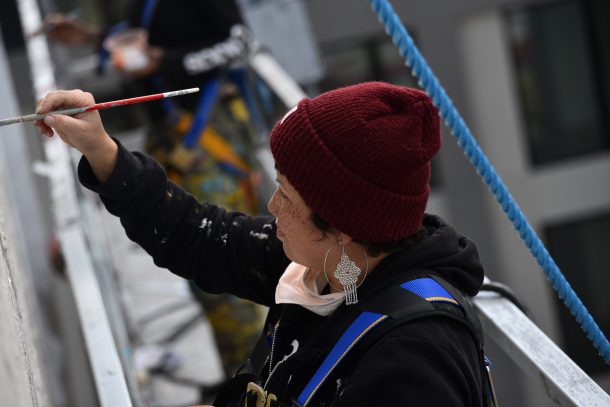
Well, beyond my mom supporting me in that, I went to San Francisco School of the Arts. I grew up in the bay. So i went to SOTA, I met my mural partner, actually, there at SOTA. We were both painting together in high school. And we had an art teacher who was a huge support. Marcia Pinon. She put us on our path. We were already kind of inching toward there anyway, but she had us applying to different art colleges, and bringing in people. So I went to CCAC in Oakland, and after that, I was kind of tired of art and I didn’t think I was going to do it, but I volunteered for a friend, who had a Precita Eyes mural. They had always been family, but I never worked with them. And, it just caught. It was the first time that I had worked with youth, these young women, it was the Mission girls, we were working alongside my friend and his friend. I know they saw the boys and the boys, they’re tough. But then they saw me painting, and they saw me painting really well, and they were like, oh we could do this! So then I was showing them how to work, and that’s the first time I realized I could be a mentor and a professional artist at the same time. I’ve been on that path since then.
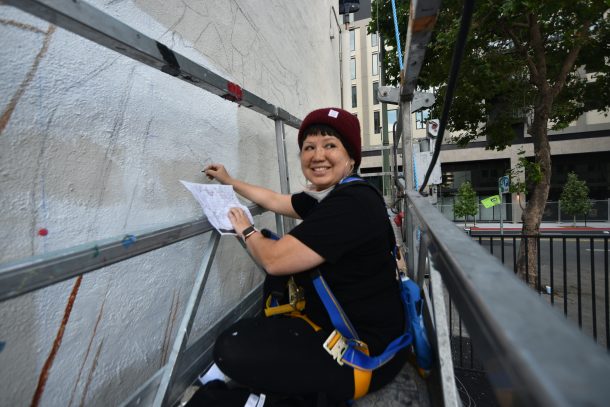
MARINA PEREZ-WONG
“I learned how to draw before I could speak. ”
I got hired the next year or so to be at Precita Eyes, to be one of their contracted artists. Yeah, I was doing that. It’s been like, 20 years. Further down the line, about seven years ago, my best friend and I started our own company. We’re a duo. Twin Walls Mural Company.
What are some of the projects you’ve done with Twin Walls?
Just recently, last week, we installed for “Paint the Void.” A mural inspired by the Navajo and Hopi natives and the buffalos that are in Golden Gate Park. We’ve been really worried about them during the corona epidemic.
Because the buffalo are sacred to the Navajo, right?
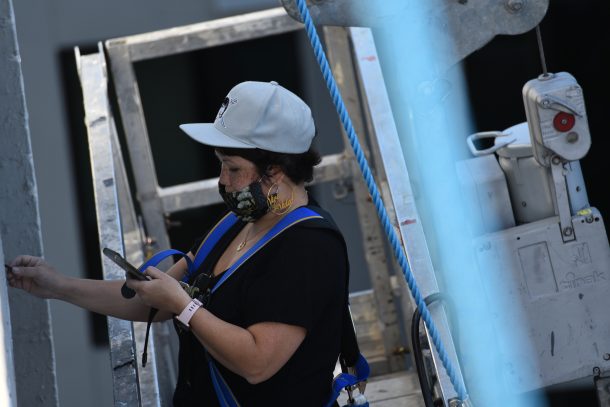
Exactly. So, it’s called, “Protectors of the Sacred: A Prayer for Buffalo Nation.” Eventually we’re gonna make prints and we’re gonna sell them and have all the proceeds go to Navajo nation and another group that’s of indigenous women. But prior to that, when we were at the Asian Art Museum, we were working with a project that’s on the corner there, called the Village Artists Corner, and they had pitched us this idea of painting goddesses, so the theme would be “Goddess” and the other portion of that was “Enlightenment.” We chose the goddess Tara, who is multifaceted. There’s supposedly like 21 or 27 versions of her. So, we focused on three that were the central pieces. The white Tara which is longevity and health. The green Tara which is compassion. And then the one that is the fighter that’s in the center is the blue Tara. She’s compassionate wrath. So, she’s engulfed in flames, she’s Kali, in other cultures, Tara is like the Virgin Mary, or she’s like the mom of all the gods. The blue Tara you have to pass through to get to enlightenment. They’re all Bodhisattvas. On the opposite side of the wall is Buddha sitting underneath the bodhi tree where they were enlightened.
It was really beautiful to work on that for me. Because it was the first mural after being diagnosed–oh yeah, I’ve got Stage 4 breast cancer–that got me back to painting. It was healing. As have all the murals been since then.
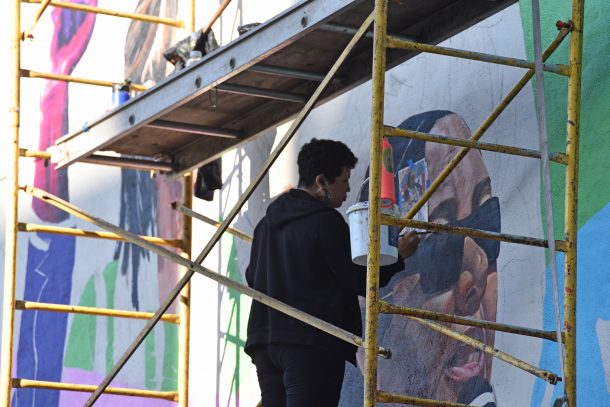
So with this project, what attracted you to this project and what are you anticipating with your involvement in it?
For one, I love that it’s the first, well I guess the second, I haven’t painted much in Oakland. And Oakland’s been my other home forever. For at least the last 20 years. And I teach here, you know, normally I teach at Oakland School for the Arts. And, it’s been my community but I haven’t done much work here. And then Desi, I always wanted to work with Desi after I had found out about his work. But i think a lot of it is the subject matter, the people involved that are gonna be created on the wall. And the fact it’s coming from a place of destruction to be recreated anew. It’s a little bit of justice. Where there was injustice. Sticking it to the man.
Whenever you can.
###
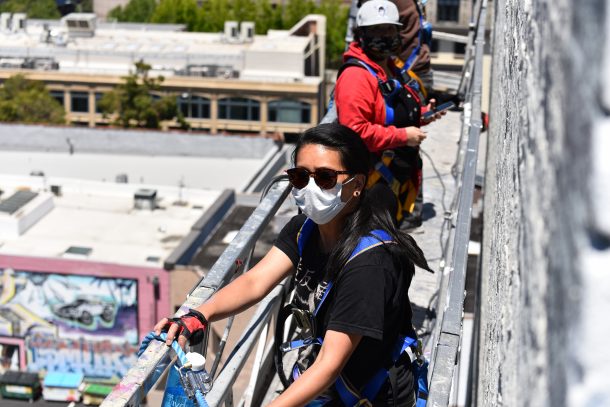
How long have you been doing murals?
Elaine Chu: My first mural was when I was 14. Professionally, I’ve been doing murals for about 10 years.
And how did that come about? Take me through the whole progression. How did you get to this point?

Well, at 14, I interned at Precita Eyes Muralists in San Francisco. That just opened my eyes to the whole mural world. I didn’t even know you could paint that way. I just found a home there and I ended up going to baltimore for school, and I studied painting. But I always came back to the Mission and Precita Eyes, and just always felt like that was my home away from home. Frome there, you know, I learned a lot from Susan Cervantes, who’s the Director and founder of Precita Eyes. She pretty much taught me everything I know. Just like, the basics, gridding, mixing colors, working that high…
Is there an overall philosophy of muralism that you learned through Precita Eyes?
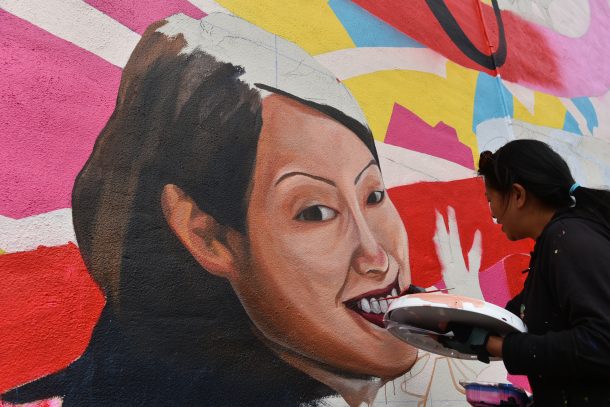
Yeah. A big one from Susan is, you want to paint what you want to manifest. So, what do you want to see in the world? And, as a muralist, your job is to ask people what they want to see in the world, and in their communities. That’s also something that I’ve learned, is how to do work with community and many many people to get a mural up with everybody’s ideas.
So, there’s a collective process, it’s not just an individual artist with one vision: here’s what’s going on the wall.
Collective process, yes. Because you’re coming into a community, and you’re helping them to visualize what they want to see. As an artist, you’re supposed to direct that process. And make sure that everybody feels like their voice is being heard and included. But then, you know, I’ve learned a lot from painting with different communities. Just like, history of each neighborhood, each community. That’s what’s the amazing part about murals, is that you’re learning yourself about who you’re painting and all the different stories.
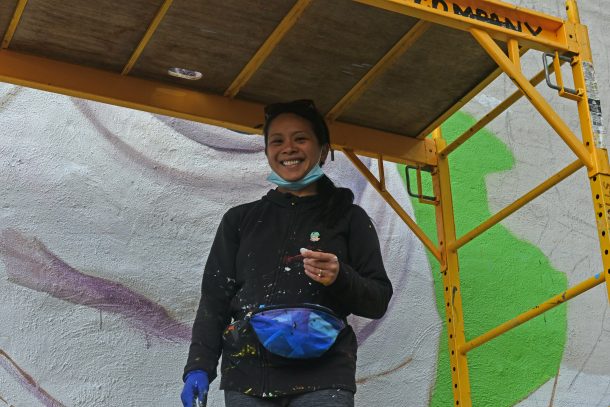
So it’s sort of like a two-way dialogue, then?
Yeah.
Interesting. And is Precita Eyes where you met Marina?
I actually met Marina in high school. We went to school together in San Francisco. We were both in Visual (Arts), and so we grew up together, and then really didn’t start hanging out until about junior year. And then, I went to Baltimore for college, she went to Oakland. CCAC. But we always kept in touch. After Baltimore, I moved to Philly, and painted there for a while. Kinda bounced around a bit, and then I moved back here. And that’s when we really started painting together. Realizing that the way we worked meshed really well together, and our styles worked together. We just generally like hanging out.
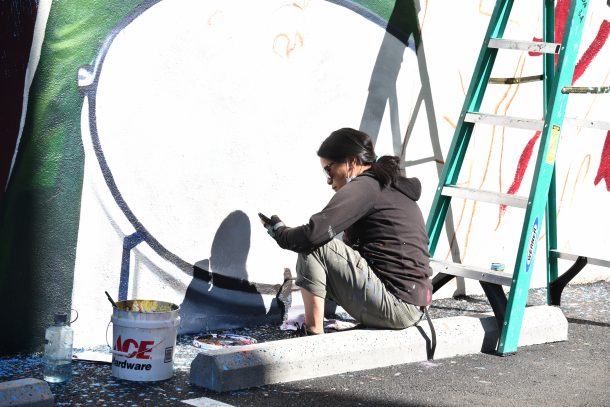
-ELAINE CHU
“People are seeing this monumental piece go up, and I think it’s unlike anything else I’ve seen in downtown Oakland. I think it’ll be really historic.”
What are some of the highlighted projects that you’ve done with Twin Walls?
I would say, the last three years have been our busiest years. I felt like we’ve really grown. Just gotten tighter. And more direct in our symbolism, you know, in our storytelling. One mural that is a highlight is a project we did for Twitter. They wanted local women artists to do a mural about women. That was pretty much all the parameters they gave us. So, you know, first they were like, well, we’re thinking the Women’s March. But we didn’t want to paint the Women’s March. We wanted to do something more symbolic. So we asked people, what women should be in this mural that are kinda like hidden figures? Women that people should know. From all over the spectrum. Arts, activism, music, writers. And so, we painted over 120 women in that mural. And, too bad it’s stuck in Twitter, because you can’t really see it. But we started thinking about, the way we brainstorm is, okay, what symbols represent women? So we started saying like, oh, water is a very feminine element. Water, the uterus, and from there, we came up with like, this ocean enveloping you that’s comprised of all these different women. In the center of the mural is a mother, a baby, and a grandmother. Showing this family unit that’s generational.
Yeah, generational, nurturing…
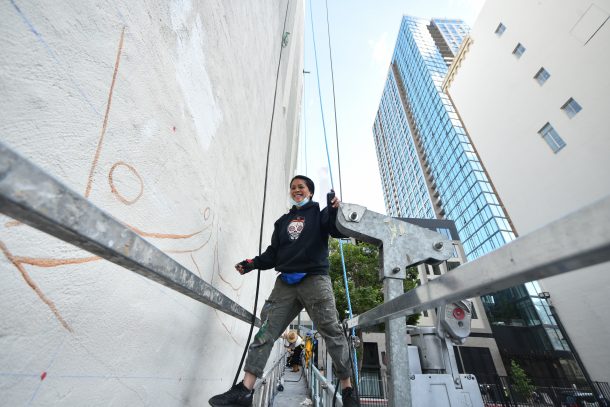
That’s been kind of a common theme. A lot of our murals are about women that are strong, looking at women but also using a lot of symbolism.
Is it challenging to be a female muralist? Are there a lot of gender dynamics in the muralist community?
Definitely. Luckily, Marina and I have had very strong women teachers. So, you know, we have a bit of an advantage, because we always work really hard, and you work harder than the guys. You just have to.
Well, we’ve seen that with this project so far. (Laughs)
(Laughs) It is challenging, because you have to kind of prove yourself to get started. Sometimes we’ve had walls where people will come up and say, oh I thought a guy was painting this. Why do people ask that? Or people will come up to you and they’ll ask you if you need help or, do you know how to climb the ladder? Stuff like that they probably wouldn’t ask if there was a guy on the wall. There’s just some challenges there, like you always have to ignore what people say sometimes.

Hold on to your convictions. But i guess the more you do it, the more people become familiar or comfortable with, ok, anyone could be doing this mural, it doesn’t have to be a guy.
Yeah, and a big goal of ours is to be examples of strong women artists painting big monumental works of art. Because you know, we just like painting big, so… the bigger the better. This wall is the biggest wall we’ve been put on so it’s been a very wonderful opportunity.
That’s a great segue actually to the next question: How did you approach this project?
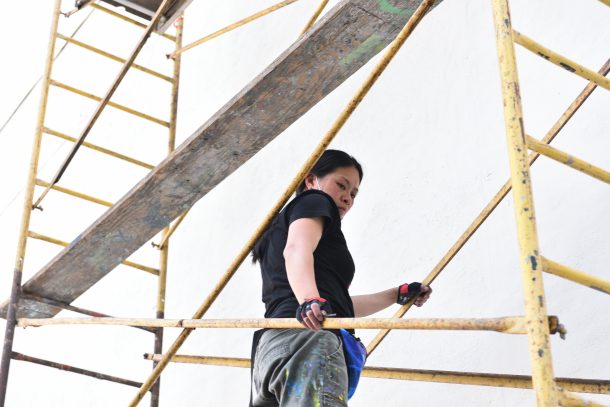
Well, we just followed desi’s lead in the design process, and you know, Marina and I are from San francisco. Marina has lived out in Oakland for a while but I just moved out to Oakland. It was really cool to be part of a community, that’s a large community project to learn about all the people that are in this mural. I still don’t know everybody. But whenever I move somewhere, I love to hear the stories and the history and just like, really get to know where I’m living. Oakland is a great place for culture and music and art.
When I jumped onto the project, Marina and Desi had already been working on the wall for a while, about a week or two. It was challenging because of the grid and just the scale of the wall, and all the challenges that come with little nuances of the wall measurements, and what-not. When I jumped on, they had already established all the groundwork.
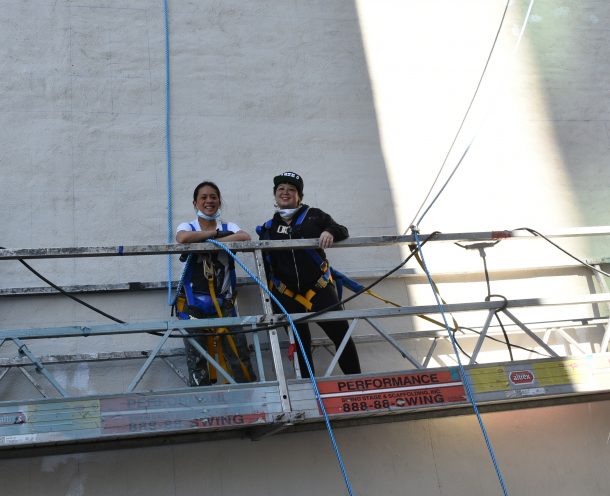
Was there something that was particularly attractive to you about this project? Where you said, hey, this is something I wanna do?
Yeah, well, it was something that i didn’t know I wanted to do. Whenever there have been swingstage projects I always shied away from that, like, I don’t know. I don’t think I could do that. And, you know, I had that fear a bit, of jumping on the swingstage. But Marina told me, it wasn’t so bad. So, I was like, alright. I trust her. I went on and I was like, okay! I think the anticipation was more than… it was fine.
What about the content of the actual mural? What appealed to you about that?
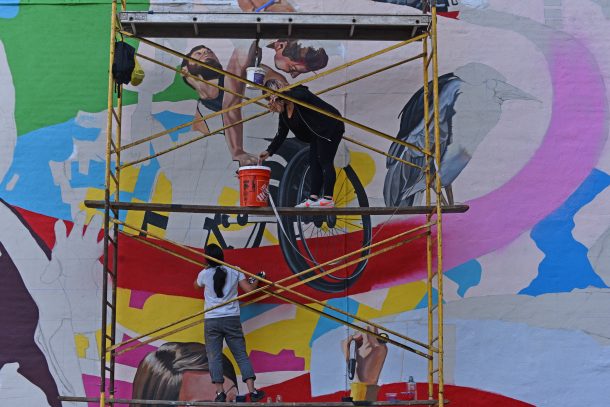
Yeah, just all the different cultures and vibrancy and energy that all these people bring to the mural is very exciting. This mural has so much movement, as do a lot of Desi’s murals. And that really attracts me. They’re very bold and they feel like they’re alive. I was a little intimidated with the amount of people that are in the mural. Just painting all of them. Like, how will we actually do this? But we’re making it happen. One portrait after the other.
So was this your first time on a swingstage?
Yes. But it’s fun! I actually enjoy it. I’ve been on sketchier scaffolding.
It seems like it’s pretty solid, it’s just that you’re way up there.
Yeah. And actually it’s a lot easier because you don’t have to climb up and down the scaffolding and haul stuff up. Everything’s there. You just go up and down.
What outcome would you ideally like to see from this mural, with everything that’s happening in Oakland, and also everything that’s happening around the country?
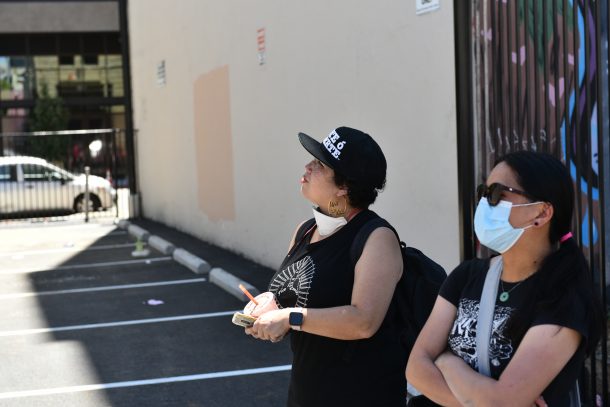
Well, I can already see people are very excited. I hope to bring joy. I think we all need a bit of that. I am so inspired by all the artwork that is popping up in downtown Oakland. It’s amazing! And that energy, we’re feeling that energy too, being right in the midst of it. And I think, probably vice-versa. People are seeing this monumental piece go up, and I think it’s unlike anything else I’ve seen in downtown Oakland. I think it’ll be really historic. Props to Desi and CRP for making this happen. I think this is gonna be one of the best murals in the Bay.
That’s saying a lot.
TWMC’s portfolio can be viewed here.

